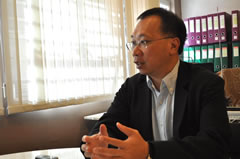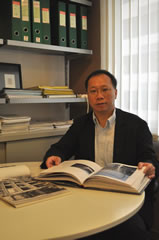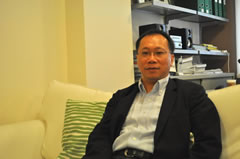| The essence of master planning: Andrew Lam
 West Kowloon Cultural District Authority (WKCDA) Board member Mr Andrew Lam Siu-lo has over 20 years of experience in urban design planning. Given his extensive participation in urban planning and project management in Hong Kong, mainland China and other locations in Asia, no one is more qualified than Andrew to discuss the master planning exercise for the WKCD. Here he explains to us the secrets of master planning, saying that it is to get the function, layout, mass and time right and the rest will follow. He talks about how a project of the WKCD’s scale poses an unprecedented challenge, and shows how a holistic master plan is required to better serve the needs of end-users. West Kowloon Cultural District Authority (WKCDA) Board member Mr Andrew Lam Siu-lo has over 20 years of experience in urban design planning. Given his extensive participation in urban planning and project management in Hong Kong, mainland China and other locations in Asia, no one is more qualified than Andrew to discuss the master planning exercise for the WKCD. Here he explains to us the secrets of master planning, saying that it is to get the function, layout, mass and time right and the rest will follow. He talks about how a project of the WKCD’s scale poses an unprecedented challenge, and shows how a holistic master plan is required to better serve the needs of end-users.
What is the purpose of master planning? How do we judge the quality of a master plan?
The first thing in master planning is to determine the use and function of the site. WKCD is primarily being built for arts and culture, but this is not the only consideration. Supporting facilities, such as transport, recreation and dining, also need to be considered. To bring together all the functions of the WKCD cohesively, a good layout is essential. A multifunctional site should have a more complex layout than a uni-functional one, given the need to address the different habits and expectations of users.
Apart from function and layout, another consideration is the mass of the buildings (i.e. how big and tall the buildings are) and their relative distances from each other. Bringing these aspects together, you get a three-dimensional space. However, there is a fourth concern, and that is time. When we look at planning, it is imperative not to see it as a blueprint, for a blueprint is dead matter. As the “ing” in the word “planning” suggests, it is a continuous process. Good planning ought to be flexible and allow for subsequent adjustments in response to the public’s future long-term needs. Of course, the Hong Kong people are eager to see some immediate outcome from the project. For instance, they will want to know the things that will be included in Phase 1 of the WKCD. What are the functions it will provide? What facilities will be developed? Will the functions be scattered or clustered? So the fact is, we also need to consider the time element. Hong Kong people need to participate actively and tell us what they think.
In other words, what we look for in a master plan is its ability to create a four-dimensional space that fully addresses the considerations of function, layout, mass and time.
 As members of the public, how can we assess the three Conceptual Plans? As members of the public, how can we assess the three Conceptual Plans?
What is a good plan? It ultimately depends on what the end-users think. No plan is completely perfect. From the perspective of a user, people are concerned about whether their expectations will be incorporated into the plan. That’s why we sought public views in Stage 1 of the Public Engagement (PE) exercise. What the public will look for in the three Conceptual Plans is whether the plans have addressed their needs. Next is the location, accessibility and propriety of the settings.
After Stage 1 of the PE exercise, the consultants reviewed their plans, incorporating the public views collected. However, while the views of the majority should be respected, minority voices must not be ignored—especially those from user groups. They are the ones who are most concerned about the project’s detailed planning. During Stage 2 of the PE exercise, we will seek public’s views on the Conceptual Plans and convey their views to WKCDA. These opinions can also help WKCD to select the preferred option.
This is quite a lengthy public consultation process. Have there been public engagement exercises of such scale for similar projects around the world? Are there any standard best practices?
Any talk about “best practices” will invite great controversy. What is meant by “best”? It is very hard to define. Every country or region has its own unique culture. A common approach to public engagement is through the Internet and multipl channels, such as public forums and focus groups, which can help the planning team effectively analyse the different levels of needs. A number of groups may also present their views and ideas in an unsolicited manner. All these are happening in WKCD.
This time the general public is expected to pick out features they consider desirable from each of the three Conceptual Plans instead of choosing one plan out of the three. What is the benefit of this approach? Will the public find it more difficult to understand?
This approach can help establish precisely what the public likes or doesn’t like about the plans. This does not mean that eventually, we will have the eyes from Plan No. 1, the nose from No. 2 and the mouth from No. 3. But if we select just one plan out of the three, we will be limited to the attributes of that plan only, probably at the expense of the other two plans, which may be superior in other respects. This is not a beauty contest where only one can emerge as the “winner”. During the engagement exercise, the public must voice their opinions in concrete terms. This will provide the WKCDA with a more comprehensive framework within which it can make adjustments and decisions accordingly.
 The fact is, planning is always difficult. The important thing is to determine the kind of planning framework the public will accept, move in that direction and then make adjustments to the details. The most difficult part is to present the public with only a plan drawn on a piece of paper. Therefore, it is common practice for planners to develop models or three-dimensional diagrams to aid the public’s understanding. At the same time, however, we must be careful not to mislead the public with the notion that the future development will look exactly like the models. The fact is, planning is always difficult. The important thing is to determine the kind of planning framework the public will accept, move in that direction and then make adjustments to the details. The most difficult part is to present the public with only a plan drawn on a piece of paper. Therefore, it is common practice for planners to develop models or three-dimensional diagrams to aid the public’s understanding. At the same time, however, we must be careful not to mislead the public with the notion that the future development will look exactly like the models.
As the Conceptual Plans do not come with specific architectural designs, we have to have some models and illustrations to help the public understand and get a better feel of the WKCD’s possible master plans—such as the size of buildings, width of the streets, spatial distribution, location of transport terminals, and links with the Express Railway Link.
Will this master planning exercise for the WKCD help reinforce Hong Kong’s international image?
Definitely. There are few projects in the world with comparable scale and vision. We have already received a great deal of global attention, which is only natural with a high-profile project like the WKCD.
The arts scene in Hong Kong has become much more buoyant in recent years, but we are still way behind New York, Paris and London. This awareness has continued to drive us forward, and we have quickened our pace significantly. Architects around the world are now closely watching the development of the WKCD, which means a lot to Hong Kong as we look to build a strong global presence. Come what may, the people of Hong Kong must stand firmly by the WKCD to make it a success.
|

